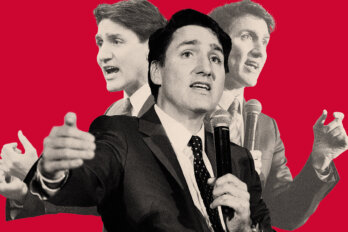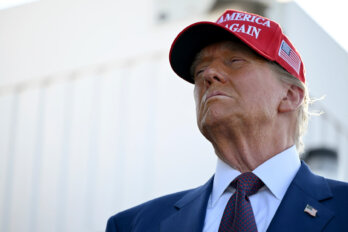When Brian Mulroney resigned from politics in 1993, among those who eagerly anticipated his leave-taking were his own domestic staff. In a cringe-inducing farewell scene captured in Stevie Cameron’s 1994 political exposé On the Take, the prime minister and his wife, Mila, bound for the French Riviera, paused to say goodbye to the maids, chef, and butler who had assembled outside the PM’s residence. After helping Mila into the waiting limousine, Mulroney mumbled, “We’re just a phone call away.” An awkward silence ensued. “What’s the number, Boss?” someone said. “Uh, just a phone call away,” Mulroney repeated, and the door slammed shut. As the limousine drove off, one maid couldn’t resist hollering, “Don’t come back!”
It would be hard to find a political career that encompassed more triumphant highs and more devastating lows than that of our eighteenth prime minister. In the 1984 federal election, Mulroney delivered the greatest landslide majority government in Canadian history to the Progressive Conservatives, who won 211 seats. Seven years later, the wrath against his party reached biblical proportions. Western Canadians hated him for selling out their interests by awarding a $100 million maintenance contract for new fighter jets to Quebec rather than Manitoba. Quebecers hated him for failing to deliver on promised constitutional reforms that would have finally recognized theirs as a distinct society. And most of the country hated him for introducing the 7 percent goods-and-services tax.
Too unpopular to win another term, Mulroney bowed out ahead of the 1993 federal election. He was replaced by Kim Campbell, but anger against him remained. When the electoral dust settled, the Liberals formed the next government, and the smouldering crater once known as the Progressive Conservative Party was left with two seats. It was the worst defeat in Canadian politics.
Twenty-five years have passed since Mulroney’s retirement. Detractors still call him “Lyin’ Brian,” and some see him as a megalomaniac who was only ever in it for the power and money. In 1995, it was revealed that the Royal Canadian Mounted Police was investigating whether Mulroney accepted kickbacks on the sale of Airbus jets to Air Canada. While he did win an apology and a $2.1 million defamation settlement from the government, the former PM later admitted to accepting envelopes stuffed with 1,000-dollar bills from German businessman Karlheinz Schreiber—part of a payout of at least $225,000 that Mulroney had earlier denied receiving under oath. And the scandals continue. Last November, news broke that his legacy project, the new $60 million Mulroney Institute of Government, had allegedly been bankrolled by billionaires mired in international bribery and corruption schemes.
Yet there is no debating it: Brian Mulroney is back. Following the 2016 United States presidential election, Justin Trudeau’s government, which had bet heavily on a Hillary Clinton victory, embraced Mulroney as a consigliere for managing relations with Donald Trump, a man he has known for years. Mulroney’s close relationships with Trump acolytes and insiders have now become invaluable national resources in the tense and ongoing negotiations over the North American Free Trade Agreement—a pact Mulroney was vilified for signing decades earlier. On January 30 of this year, he testified before the US Senate Committee on Foreign Relations, where he sold NAFTA as an economic triumph for all involved and spoke stirringly of Canada-US relations as “the most successful and peaceful bilateral relationship in world history.” That the son of Pierre Elliott Trudeau, Mulroney’s former political nemesis, is now fighting to defend the centrepiece of Mulroney’s policy legacy is the clearest sign that Mulroney is entitled to bragging rights. “Nobody has achievements like this,” he said in an interview published in 2006, with a swagger we might now dub Trumpian. “You cannot name a Canadian prime minister who has done as many significant things as I did, because there are none.”
Fen Osler Hampson would agree. In his new book Master of Persuasion: Brian Mulroney’s Global Legacy, Hampson tells the story of a transformative leader who changed Canada’s foreign relationships and improved our standing in the world. Hampson achieves that goal effortlessly, detailing how Mulroney backed Commonwealth sanctions in 1986 against South Africa to help bring an end to apartheid, persuaded President George H. W. Bush to seek United Nations backing for the 1990 Gulf War, and was a constant campaigner for human rights. But the book also underscores the extent to which Mulroney’s re-emergence is tied to the fact that he’s in possession of a set of skills now in short supply—he’s an elder statesman alive in an era that’s forgotten the first principles of the dark art he practices. Like Rocky Balboa in the movie Creed, Mulroney has been called out of retirement to remind us of his old winning ways.
Little in Mulroney’s childhood suggested he was destined for the country’s highest political office. His father toiled as an electrician at the local mill in Baie-Comeau, Quebec, and the family scraped by on his hourly wage. Mulroney grew up an anglophone Catholic in a francophone town where most English speakers were Protestant—linguistic and religious barriers cast him as an outsider. Yet, from an early age, Mulroney could ingratiate himself with insiders and place himself at the centre of attention. Decades before he crooned “When Irish Eyes are Smiling” with Ronald Reagan in Quebec City, young Brian performed “Dearie” for Robert R. McCormick, the newspaper baron and founder of Baie-Comeau, who supposedly slipped the twelve-year-old a $50 bill.
Mulroney would go on to a successful career, during the 1970s, as a labour lawyer and, later, a business executive. Central to his political rise was his talent for cultivating close personal and professional relationships, a skill Hampson describes as “legendary.” Contacts were organized according to hubs and spokes. Hubs, according to Mulroney biographer John Sawatsky, were a select group of influencers in a city or area. They would get calls from Mulroney as often as every week. Spokes—a larger group, generally under the sway of hubs—might receive only one or two calls a year. But if a spoke was promoted, appeared in the newspaper, or experienced a death in the family, Mulroney would fire off a personal note. He remembered details such as birthdays and children’s names, and he used this familiarity to draw out gossip and stay abreast of developments in law, business, and politics. The result was a vast intelligence-gathering operation. If Mulroney, or one of his clients, encountered resistance in a negotiation or labour dispute, he would leverage his Rolodex to sweeten the deal or gain concessions. He always knew a guy.
Mulroney’s social network was his life’s work, and after he occupied the prime minister’s official residence on 24 Sussex Drive, the reach of his network grew. Mulroney’s hubs now included major leaders of the free world: Reagan, Nelson Mandela, German chancellor Helmut Kohl, French president François Mitterrand. But while the theatre of operations expanded, the basic system stayed the same. If he needed to make a deal, Mulroney picked up the phone. In the lead up to the Gulf War, Bush tasked Mulroney with calling Egyptian president Hosni Mubarak in order to bring the Arab world into the US-led coalition force against Saddam Hussein.
Mulroney’s personal clout played a crucial role in one his most controversial successes: the 1989 Canada-United States Free Trade Agreement, which would become NAFTA with the inclusion of Mexico in 1994. At the time, Mulroney’s decision to pursue free trade with the US elicited fierce domestic opposition. In 1988 election ads, the NDP warned that the free-trade agreement would kill the Canadian health care system, and the Liberals implied it would lead to Canada’s annexation by the US. Luminaries of Canadian culture made the case in more colourful terms: “About the only position [the Americans] have adopted toward us,” Margaret Atwood said, “has been the missionary position, and we were not on top.”
The immediate issue with the free-trade agreement, however, wasn’t American rapacity but the fact that politicians south of the border weren’t particularly interested. Before the deal was signed, negotiators slogged through several rounds of talks, getting nowhere. Hours before Congress’s authority to fast-track the legislation was set to expire, Mulroney placed a call to Reagan. Hampson reports that Mulroney asked the president how, at the height of tensions with the Soviet Union, the US could “conclude a nuclear arms reduction agreement with its Cold War adversary, and at the same time fail to summon the will to conclude a trade agreement with its Canadian ally and neighbour.” A final deal was tabled within the hour.
The numbers alone suggest Mulroney has been vindicated. Canadian trade with US and Mexico increased from $222 billion in 1989 to more than $850 billion in 2015. But the triumph of NAFTA has also meant that a generation of Canadian politicians, having learned to take the trade deal for granted, never expected they would now find themselves scrambling to save it. After Trump called it “one of the worst deals ever made” and threatened to pull out, the Trudeau Liberals activated Mulroney to make the Canadian case. As he reminded the US Senate committee during his appearance this January, “With less than 7 percent of the world’s population, NAFTA partners…represented 28 percent of the world’s total GDP.”
Mulroney’s rhetorical style has always drifted toward exaggeration, and his performance before the Senate committee was no different. He hadn’t fudged the numbers, but the overall effect of his presentation was to inflate the risks associated with losing NAFTA In fact, according to Douglas Porter, chief economist at BMO Financial Group, the cost of terminating NAFTA would be a 1 percent drop in economic growth over the next five years: leaving NAFTA, he wrote, “Is a manageable risk that policymakers, businesses, and markets would adjust to in relatively short order.” True, the Canadian GDP has nearly doubled since 1993, but the average full-time hourly wage has been “essentially unchanged” since 1975, according to Statistics Canada. NAFTA delivered the goods for investors, but the benefits for the rest of us are mostly theoretical.
Of course, Mulroney was not sent to Washington to provide an unvarnished assessment of the details. He was sent to varnish. His testimony in front of the Senate committee was characterized by the performative charm, soaring rhetoric, and twinkle-eyed blarney that delivered him two majority governments. Did it work? As of this writing, negotiators have wrapped up seven rounds of talks with little to show. Skeptics might argue that Mulroney was simply doing what he has always done: find a way to place himself at the centre of the action.
For readers of Hampson’s book, it can be hard to believe that the man being described is the same politician who, during campaigns, was attacked as the “big money” candidate and whose lavishly renovated closets at 24 Sussex Drive reportedly housed fifty pairs of Gucci loafers.
Hampson portrays someone who, to an extent true of few prime ministers before and none since, had a clear vision of Canada’s moral influence on the world and mobilized the resources and political capital to make that vision a reality. Mulroney’s government drew international attention to the 1984 Ethiopian famine and spearheaded relief efforts that saved millions of lives. It likewise led the international community in calling for a response to ethnic cleansing in the former Yugoslavia. During Mulroney’s tenure, Canada telegraphed its principles in symbolic ways, such as our “first to pay” policy, in which Canadian officials hand delivered contribution cheques to the UN. But the symbolism was backed by concrete force. “Canada was an active participant in all sixteen UN peacekeeping missions that took place while Mulroney was in office,” Hampson writes, “contributing more than 10 percent of all troops assigned to the UN.” Today, that proportion is less than 0.1 percent.
As Hampson details, one of Mulroney’s greatest achievements as prime minister was also one of the hardest won: a bilateral treaty with the United States to combat acid rain. Reagan—who had declared that trees cause more air pollution than automobiles—didn’t budge, at first. But Mulroney kept chipping away at him and at the issue. This campaign included delivering a piercing jeremiad before a joint session of the US Congress in 1988 (“What would be said of a generation of North Americans that found a way to explore the stars but allowed its lakes and forests to languish and die?”). For the next three years, he went on CNN to scold recalcitrant members of the administration, had his own team leak a memo depicting Canadian outrage at American inaction, and—most importantly—nurtured key congressional allies. Indeed, Mulroney’s “constant schmoozing,” Hampson reports, “was critical.”
The Canada-United States Air Quality Agreement was finally signed in 1991. His success on the file, combined with his passage of the ambitious Environmental Protection Act, which required seven provinces to cut sulphur dioxide emissions by half, prompted a 2006 survey of environmental experts to call Mulroney the greenest prime minister in Canadian history.
But the qualities central to Mulroney’s triumphs—his artful backroom dealing, emphasis on personal connections, and outsized confidence—also fed his failures and eventual downfall. Hampson leans on the charming tale, the sentimental anecdote, and moments of masculine camaraderie that belong in a Hollywood buddy picture. (“You know, Brian,” Reagan is once supposed to have remarked, throwing his arm around Mulroney’s shoulder, “for two Irishmen, we sure married up!”) Unfortunately, Hampson also sanitizes his subject. We know, thanks to investigative journalist Stevie Cameron, that blue-chip donors enjoyed unparalleled access to the highest levels of Mulroney’s government, with officials receiving payments in return for lucrative office deals, engineering contracts, and government grants.
Looking back, we can see how Mulroney punctures a misconception about politics: that corruption and achievement are mutually exclusive. Sure, it’s easier to celebrate the accomplishments of a leader who does not reek of venality, but the truth is much messier. Mulroney may hail from Baie-Comeau, but like Jay Gatsby, he “sprang”—in F. Scott Fitzgerald’s words—“from his Platonic conception of himself.” Mulroney’s self-styled mythology, however, suffers from its own limitations. His cultivated aura of celebrity worked marvels among his legions of contacts but struck many Canadians as haughty and aloof. In transcending his ordinariness, he ended up holding the confidence of everyone but Canadian voters. By the time Mulroney left politics, his support had hit 15 percent.
How did a prime minister of Mulroney’s accomplishments become so despised? Perhaps the answer is not simply the GST or the gradual accumulation of scandal. Perhaps the real disappointment stems from the fact that Mulroney’s need for approval was our shared national condition. We glimpse in him an incarnation of the insecurity lurking at the very bottom of the Canadian psyche. We thrilled to his global triumphs, then felt personally betrayed by his apparent self-interestedness. In some deep sense, Mulroney is still that needy twelve-year-old from Baie-Comeau, reaching out for validation in the form of a fifty.





